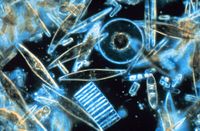
Photo from wikipedia
A multi-residue method for determining 81 pesticides and metabolite residues in vegetables and fruits by liquid chromatography/ tandem mass spectrometry (LC/MS/MS) with electrospray ionization was developed. Pesticide residues were extracted… Click to show full abstract
A multi-residue method for determining 81 pesticides and metabolite residues in vegetables and fruits by liquid chromatography/ tandem mass spectrometry (LC/MS/MS) with electrospray ionization was developed. Pesticide residues were extracted from samples with acetone. Macroporous diatomaceous earth column was used instead of the separatory funnel for liquid/liquid extraction. Ethyl acetate was used as eluting solvent for diatomaceous earth column. This sample preparation technique by diatomaceous earth column was easy, fast and environment-friendly. It can reduce the sample preparation time and solvent consumption as well as eliminate the emulsion problem. Eighty-one analytes of different chemical families of insecticides, acaricides, fungicides, herbicides, plant growth regulators and 4 pesticide metabolites were determined in a single 25 min LC/MS/MS run. The pesticides were separated on an Atlantis T3 column using a gradient elution. Data acquisition under MS/MS for every pesticide or metabolite was achieved by applying multiple reaction monitoring (MRM) of two fragment ion transitions to provide high sensitivity and selectivity for both quantification and confirmation. A total of 162 MRM transitions were monitored. The standard addition was employed to compensate for the matrix effects to achieve the maximum accuracy of the LC/MS/MS method. Vegetable (bok choy) and fruit samples (grape or orange) were fortified with pesticides of low (0.05 or 0.1 ppm) and high (0.5 ppm) levels, and the triplicate results showed satisfactory recoveries and repeatability. The recoveries for most pesticides ranged from 70 to 120% and the coefficients of variation of all pesticides were below 25% in all matrices. The developed method, compared with traditional GC or LC method, showed less time-consumption and higher sensitivity. The proposed method is considered satisfactory for routine monitoring of pesticide residues in fruits and vegetables.
Journal Title: Journal of Food and Drug Analysis
Year Published: 2020
Link to full text (if available)
Share on Social Media: Sign Up to like & get
recommendations!